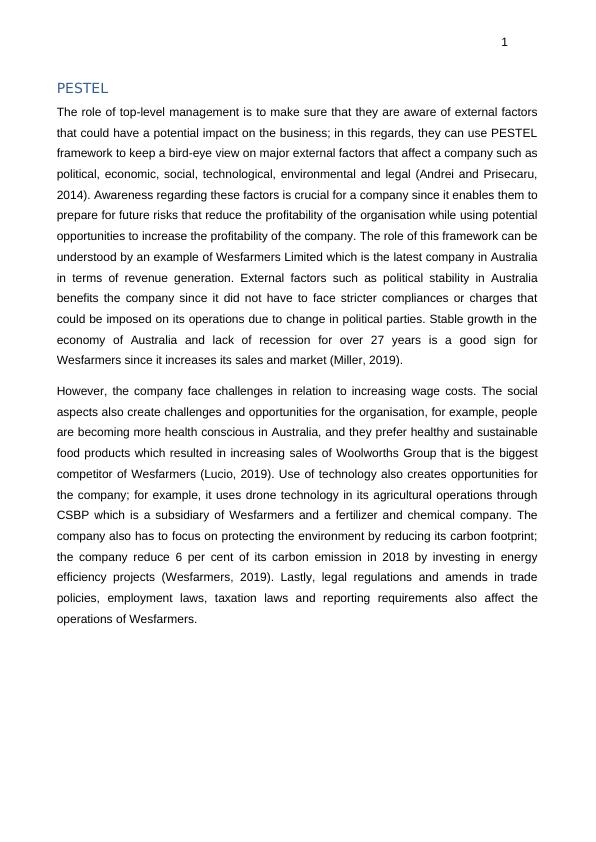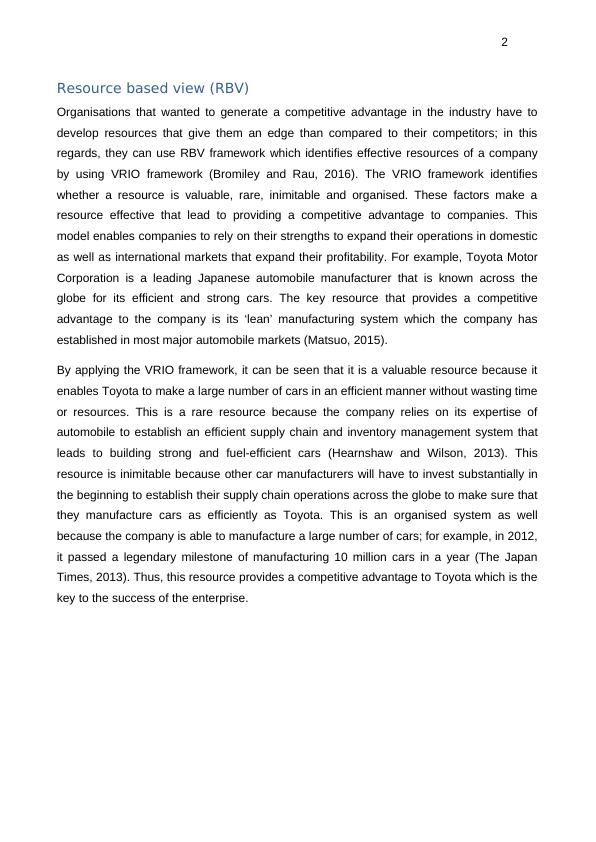Competitive Strategy: PESTEL, RBV, Five Forces, SWOT
Added on 2023-01-23
7 Pages1831 Words55 Views
Competitive Strategy

1
PESTEL
The role of top-level management is to make sure that they are aware of external factors
that could have a potential impact on the business; in this regards, they can use PESTEL
framework to keep a bird-eye view on major external factors that affect a company such as
political, economic, social, technological, environmental and legal (Andrei and Prisecaru,
2014). Awareness regarding these factors is crucial for a company since it enables them to
prepare for future risks that reduce the profitability of the organisation while using potential
opportunities to increase the profitability of the company. The role of this framework can be
understood by an example of Wesfarmers Limited which is the latest company in Australia
in terms of revenue generation. External factors such as political stability in Australia
benefits the company since it did not have to face stricter compliances or charges that
could be imposed on its operations due to change in political parties. Stable growth in the
economy of Australia and lack of recession for over 27 years is a good sign for
Wesfarmers since it increases its sales and market (Miller, 2019).
However, the company face challenges in relation to increasing wage costs. The social
aspects also create challenges and opportunities for the organisation, for example, people
are becoming more health conscious in Australia, and they prefer healthy and sustainable
food products which resulted in increasing sales of Woolworths Group that is the biggest
competitor of Wesfarmers (Lucio, 2019). Use of technology also creates opportunities for
the company; for example, it uses drone technology in its agricultural operations through
CSBP which is a subsidiary of Wesfarmers and a fertilizer and chemical company. The
company also has to focus on protecting the environment by reducing its carbon footprint;
the company reduce 6 per cent of its carbon emission in 2018 by investing in energy
efficiency projects (Wesfarmers, 2019). Lastly, legal regulations and amends in trade
policies, employment laws, taxation laws and reporting requirements also affect the
operations of Wesfarmers.
PESTEL
The role of top-level management is to make sure that they are aware of external factors
that could have a potential impact on the business; in this regards, they can use PESTEL
framework to keep a bird-eye view on major external factors that affect a company such as
political, economic, social, technological, environmental and legal (Andrei and Prisecaru,
2014). Awareness regarding these factors is crucial for a company since it enables them to
prepare for future risks that reduce the profitability of the organisation while using potential
opportunities to increase the profitability of the company. The role of this framework can be
understood by an example of Wesfarmers Limited which is the latest company in Australia
in terms of revenue generation. External factors such as political stability in Australia
benefits the company since it did not have to face stricter compliances or charges that
could be imposed on its operations due to change in political parties. Stable growth in the
economy of Australia and lack of recession for over 27 years is a good sign for
Wesfarmers since it increases its sales and market (Miller, 2019).
However, the company face challenges in relation to increasing wage costs. The social
aspects also create challenges and opportunities for the organisation, for example, people
are becoming more health conscious in Australia, and they prefer healthy and sustainable
food products which resulted in increasing sales of Woolworths Group that is the biggest
competitor of Wesfarmers (Lucio, 2019). Use of technology also creates opportunities for
the company; for example, it uses drone technology in its agricultural operations through
CSBP which is a subsidiary of Wesfarmers and a fertilizer and chemical company. The
company also has to focus on protecting the environment by reducing its carbon footprint;
the company reduce 6 per cent of its carbon emission in 2018 by investing in energy
efficiency projects (Wesfarmers, 2019). Lastly, legal regulations and amends in trade
policies, employment laws, taxation laws and reporting requirements also affect the
operations of Wesfarmers.

2
Resource based view (RBV)
Organisations that wanted to generate a competitive advantage in the industry have to
develop resources that give them an edge than compared to their competitors; in this
regards, they can use RBV framework which identifies effective resources of a company
by using VRIO framework (Bromiley and Rau, 2016). The VRIO framework identifies
whether a resource is valuable, rare, inimitable and organised. These factors make a
resource effective that lead to providing a competitive advantage to companies. This
model enables companies to rely on their strengths to expand their operations in domestic
as well as international markets that expand their profitability. For example, Toyota Motor
Corporation is a leading Japanese automobile manufacturer that is known across the
globe for its efficient and strong cars. The key resource that provides a competitive
advantage to the company is its ‘lean’ manufacturing system which the company has
established in most major automobile markets (Matsuo, 2015).
By applying the VRIO framework, it can be seen that it is a valuable resource because it
enables Toyota to make a large number of cars in an efficient manner without wasting time
or resources. This is a rare resource because the company relies on its expertise of
automobile to establish an efficient supply chain and inventory management system that
leads to building strong and fuel-efficient cars (Hearnshaw and Wilson, 2013). This
resource is inimitable because other car manufacturers will have to invest substantially in
the beginning to establish their supply chain operations across the globe to make sure that
they manufacture cars as efficiently as Toyota. This is an organised system as well
because the company is able to manufacture a large number of cars; for example, in 2012,
it passed a legendary milestone of manufacturing 10 million cars in a year (The Japan
Times, 2013). Thus, this resource provides a competitive advantage to Toyota which is the
key to the success of the enterprise.
Resource based view (RBV)
Organisations that wanted to generate a competitive advantage in the industry have to
develop resources that give them an edge than compared to their competitors; in this
regards, they can use RBV framework which identifies effective resources of a company
by using VRIO framework (Bromiley and Rau, 2016). The VRIO framework identifies
whether a resource is valuable, rare, inimitable and organised. These factors make a
resource effective that lead to providing a competitive advantage to companies. This
model enables companies to rely on their strengths to expand their operations in domestic
as well as international markets that expand their profitability. For example, Toyota Motor
Corporation is a leading Japanese automobile manufacturer that is known across the
globe for its efficient and strong cars. The key resource that provides a competitive
advantage to the company is its ‘lean’ manufacturing system which the company has
established in most major automobile markets (Matsuo, 2015).
By applying the VRIO framework, it can be seen that it is a valuable resource because it
enables Toyota to make a large number of cars in an efficient manner without wasting time
or resources. This is a rare resource because the company relies on its expertise of
automobile to establish an efficient supply chain and inventory management system that
leads to building strong and fuel-efficient cars (Hearnshaw and Wilson, 2013). This
resource is inimitable because other car manufacturers will have to invest substantially in
the beginning to establish their supply chain operations across the globe to make sure that
they manufacture cars as efficiently as Toyota. This is an organised system as well
because the company is able to manufacture a large number of cars; for example, in 2012,
it passed a legendary milestone of manufacturing 10 million cars in a year (The Japan
Times, 2013). Thus, this resource provides a competitive advantage to Toyota which is the
key to the success of the enterprise.

End of preview
Want to access all the pages? Upload your documents or become a member.
Related Documents
Strategy Development Tools for Competitive Advantagelg...
|7
|1740
|80
Corporate Strategy: PESTEL Analysis, Porter's Five Force Model, Value Chain Analysis, VRIO Modellg...
|10
|4300
|76
Evaluation of Strategy Development Tools for Competitive Advantagelg...
|7
|1734
|464
Strategic Management | Case Study Report-1lg...
|14
|3016
|19
Capstone Strategy Assignment Reportslg...
|18
|1686
|13
Business Environment Analysis of British Gas: Industry and Firm Analysislg...
|12
|2934
|374